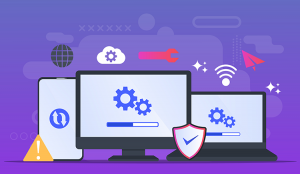 In today’s fast-paced digital world, educational institutions face a growing demand for efficient and reliable IT solutions. One of the most critical decisions they face is whether to choose an on-premises server solution or a cloud-based IT system. Both options have their benefits and drawbacks, which must be considered before making a final decision.
In today’s fast-paced digital world, educational institutions face a growing demand for efficient and reliable IT solutions. One of the most critical decisions they face is whether to choose an on-premises server solution or a cloud-based IT system. Both options have their benefits and drawbacks, which must be considered before making a final decision.
On-Premises Server Solution
An on-premises server solution is a system where all IT resources are housed on-site, meaning hardware and software are stored locally in the educational institution. An on-premises server is often referred to as a “traditional” IT infrastructure. The pros of an on-premises server solution include:
- Control and Security: With an on-premises server solution, the educational institution has complete control over the system’s security and data. All data is stored locally, and the IT staff can monitor and manage security protocols, ensuring data privacy and protection.
- Cost-Effective: In the long term, an on-premises server solution may be more cost-effective than cloud-based systems. Once the infrastructure is set up, the institution can control its costs, and there is no need for ongoing subscription fees.
- Customisable: On-premises servers can be customised to meet the unique needs of the educational institution. This means that they can choose specific hardware and software solutions that meet their requirements.
However, there are also several cons associated with on-premises server solutions, including:
- Maintenance and Upgrades: On-premises servers require regular maintenance and upgrades, which can be expensive and time-consuming. The IT staff must handle all upgrades, installations, and repairs, taking away valuable resources that could be used elsewhere.
- Scalability: On-premises servers have limited scalability compared to cloud-based systems. As the institution grows and more resources are required, the server’s capacity may need to be increased, which can be a costly process.
- Disaster Recovery: On-premises servers are vulnerable to natural disasters, theft, and other physical events that could compromise the institution’s data.
Cloud-Based IT System
Cloud-based IT systems are hosted on remote servers managed by third-party providers, such as Microsoft or Google. The system can be accessed from anywhere with an internet connection, providing flexibility and scalability. The pros of a cloud-based IT system include:
- Scalability: Cloud-based systems are highly scalable, allowing the educational institution to add or remove resources as needed. This means that as the institution grows and expands, it can easily adapt its IT resources.
- Reduced IT Costs: Cloud-based systems can significantly reduce IT costs by eliminating the need for on-site IT staff. The provider is responsible for all maintenance and upgrades, allowing the institution to focus on other priorities.
- Disaster Recovery: Cloud-based systems have built-in disaster recovery solutions that are more resilient and help ensure the safety and continuity of data in the event of a natural disaster, theft, or other physical event.
However, there are also several cons associated with cloud-based IT systems, including:
- Dependence on Internet Connectivity: Cloud-based systems rely on an internet connection to function, meaning that if the connection is lost, the institution may lose access to critical resources. This can be a significant issue if the internet connection is unreliable.
- Security Concerns: With cloud-based systems, the institution must rely on the provider to ensure data privacy and security. While reputable providers offer robust security protocols, the institution must trust the provider to protect its data.
- Limited Customisation: Cloud-based systems may not be as customisable as on-premises servers, meaning that the institution may have to make compromises when it comes to specific hardware and software solutions.
Ultimately, the decision to choose an on-premises server solution or a cloud-based IT system depends on the specific needs and priorities of the educational institution.
On-premises servers offer more control and customisation options, but require more maintenance and may not be as scalable as cloud-based systems. Cloud-based systems offer greater scalability, reduced IT costs, and built-in disaster recovery solutions, but may be more vulnerable to internet connectivity issues and have limited customisation options.
Educational institutions must carefully weigh the pros and cons of each option before making a final decision to ensure that their IT infrastructure is efficient, reliable, and cost-effective.



